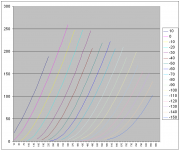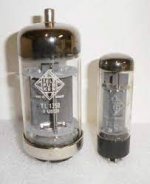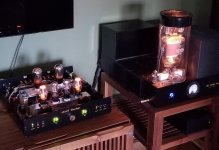IMHO, the best tube to get high SE power at 400V (max 450V) is the YL1350...22 mA/V gm, 80W plate dissipation. Simply a beast! 😀
This time the price to pay is the cost but this is not more expensive than other "boutique" 300B's and similar. Not even close actually....
What one gets tough is 32-40W with 400-450V plate voltage (200V for g2), a relatively easy to build OPT (low primary impedance in the 2-2.5K range) and easy to drive 23-26V peak in the worst case....all kinds of feedbacks are possible and not difficult to implement. More than this I don't think is possible.
This time the price to pay is the cost but this is not more expensive than other "boutique" 300B's and similar. Not even close actually....
What one gets tough is 32-40W with 400-450V plate voltage (200V for g2), a relatively easy to build OPT (low primary impedance in the 2-2.5K range) and easy to drive 23-26V peak in the worst case....all kinds of feedbacks are possible and not difficult to implement. More than this I don't think is possible.
IMHO, the best tube to get high SE power at 400V (max 450V) is the YL1350...22 mA/V gm, 80W plate dissipation. Simply a beast! 😀
This time the price to pay is the cost but this is not more expensive than other "boutique" 300B's and similar. Not even close actually....
What one gets tough is 32-40W with 400-450V plate voltage (200V for g2), a relatively easy to build OPT (low primary impedance in the 2-2.5K range) and easy to drive 23-26V peak in the worst case....all kinds of feedbacks are possible and not difficult to implement. More than this I don't think is possible.
TO asked for a thoriated tungsten filament tube, and is happy with 3 watts of output power .....
TO asked for a thoriated tungsten filament tube, and is happy with 3 watts of output power .....
Really? Have you read the thread?
Yes I have, starting with the thread's name....
Then I read the first post, so yes, it became clear that the TO is happy with 3 watts...
Did you read the thread??
Then I read the first post, so yes, it became clear that the TO is happy with 3 watts...
Did you read the thread??
I have already answered that question ages ago. So? You are late....and you haven' read the full thread.
My last post was a provocation to say that I consider certain applications just a waste of energy.
My last post was a provocation to say that I consider certain applications just a waste of energy.
A lot of those thoriated tungsten tubes glow as bright as a regular light bulb. Plate resistances tend to be very high in them, which makes for poorly performing high turns-ratio OPTs, and B+ voltages near 1100Vdc are often needed, which qualifies them for widow-maker duty. They may be cool looking and all, but they are grossly inefficient and don't sound all that good, either, since they were usually designed for RF, not audio use. I'd stay with tubes designed for audio use, especially at the low power you need.
High tube Rp is not an excuse for a poorly performing OPT. But a poor OPT designer could be the reason.
Member
Joined 2009
Paid Member
2x425, nothing special. 470 uF/450V caps are permitted. 425V was regulated to get 360V for G2, +/- 60V regulated for G3 and MOSFET driver. 20V SMPS for filaments. To start it, a bridge from 12V to filaments heats up them.
Split supplies, + and - 425V or stacked ?
I read safety risk is not linear with voltage, it gets much worse as voltage increases.
TO asked for a thoriated tungsten filament tube, and is happy with 3 watts of output power .....
There is a group of tubes that maay be interesting.
I have used the 10Y for quite a long time. Output: above 3 watts like many say, equal to 300B and . . . less distortion??
Well the secret is a follows: run it from a 6SJ7 (like a classic WE91A that uses the
- 6-pin version of that same tube);
- then as output a 10Y, LONG PLATE version.
- A 7-10K output transformer.
There is also a short anode plate version of the 10Y maybe commonly named as 10, that has less power I expect, but I have them not used them.
The plate current of the 10Y is low, say 30 mA. Quite a difference from the 300B.
I bought a cheap 7K/8ohm amorphous transformer on the bay for it.
It is not a pain to drive it, no high input capacitance. It is a transmission valve.
So MINHAJ, looking at your list that reflects your sacred goal:
1. Low cost --> not low any more.
2. Outpout transformer should be 3k or 5k --> is higher but I ran it with 5K for 10 years
3. B+ 400volt max --> I ran it at 380Volt & 30 mA
4. Class A1 only (no grid current) --> no grid current, can accept high value Rg
5. Triode or shade feedback output - --> no feedback needed but can be to input in classical way.
6. 3 watt output --> can get that safely
2. Outpout transformer should be 3k or 5k --> is higher but I ran it with 5K for 10 years
3. B+ 400volt max --> I ran it at 380Volt & 30 mA
4. Class A1 only (no grid current) --> no grid current, can accept high value Rg
5. Triode or shade feedback output - --> no feedback needed but can be to input in classical way.
6. 3 watt output --> can get that safely
I get annoyed at the 300B. High current in class A but I cannot drive it to the bottom. Lots of waste.
The 10Y is a gentleman to drive. Sophisticated.
How about triode strapped 4E27A, 7.5V 5A filament, favorable A1 curves for a low voltage design. Plate resistance 1.2K. A question is how hot to run the 125W tantalum plate to generate self getter balanced against a practical output transformer.

https://frank.pocnet.net/sheets/088/4/4E27A.pdf

https://frank.pocnet.net/sheets/088/4/4E27A.pdf
Last edited:
Split supplies, + and - 425V or stacked ?
I read safety risk is not linear with voltage, it gets much worse as voltage increases.
Something like 2x280V secondary. 🙂
You are right, class D kit with 12V wallwart would be much safer.
Split supplies, + and - 425V or stacked ?
I read safety risk is not linear with voltage, it gets much worse as voltage increases.
I must be living on borrowed time, then. 7 years of playing with 2.3kV...and loving the sound as much as the risk! Time to call my insurance salesman...
Attachments
Last edited:
Well; usually GM-70 and GK-71 tubes are working at 1.2 KV or more, for 30W output. I got 45W from 850V only.
10Y, LONG PLATE version.
Long plate version (military VT25A) produces greater power than short plate 10Y (VT25), but it's not thoriated tungsten filament tube (has barium oxide filament).
Portrait of a tube. VT25, VT25A, 10, 10Y
Member
Joined 2009
Paid Member
Thank you everybody for all the interesting inputs, it made the thread quite vibrant.
1. Low cost
2. Output transformer should be 3k or 5k
3. B+ 400volt max
4. Class A1 only (no grid current)
5. Triode or shade feedback output
6. 3 watt output
To meet the above conditions I think Hy69 (in triode connection) is a better candidate.
Plate to Cathode 300 volt, 50ma current, grid voltage -?, 5K opt. Is it good for staying in A1 region? Anybody please give me triode connection plate transfer curve, I will be most obliged.
Regards
1. Low cost
2. Output transformer should be 3k or 5k
3. B+ 400volt max
4. Class A1 only (no grid current)
5. Triode or shade feedback output
6. 3 watt output
To meet the above conditions I think Hy69 (in triode connection) is a better candidate.
Plate to Cathode 300 volt, 50ma current, grid voltage -?, 5K opt. Is it good for staying in A1 region? Anybody please give me triode connection plate transfer curve, I will be most obliged.
Regards
Hi euro21...I can go for 801a with 550-600volt B+ and 10K-12K opt and stay in A1 but that will be costly for me.
Triode data/plate curve for 865, hy69, 2e25 anybody. Then I could design/consider if it fits my criteria.
Regards
The 845 is a good audio tube. It should run SE or PP at moderate plate voltage. These tubes were audio drivers in some broadcast (AM) transmitters...The 811A was used in the Gotham-Grampian disk cutting amplifier (in push pull)... The 8005 was used in the McIntosh MI-200 amplifier (in push pull).
It is good to see high voltage safety reminders..most of the transmitting tubes have high voltage plate cap connections. Always use the insulated plate cap connectors and good quality high voltage rated wire when working with elevated voltages. The run of the mill hookup wire rated for 600 volts will break down at elevated voltage. Make sure power is OFF, wait for capacitors to discharge, and short HV connections to ground to be sure before working on HT circuits.
- Home
- Amplifiers
- Tubes / Valves
- SE Amp with Thoriated Tungsten output tube


